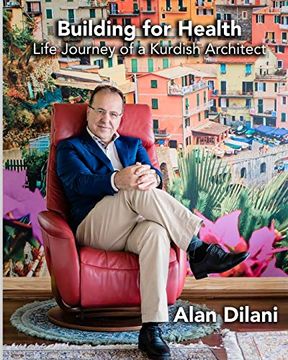Reseña del libro "Building for Health: Life Journey of a Kurdish Architect (en Inglés)"
In the twenty years I’ve known Alan, I’ve witnessed his research expanding from case studies in Sweden to a global exploration of the life-giving impact of spatial design on health. Well recognized and globally honored, his ndings today attract ever more interest and practical application. is is a groundbreaking book. May its inspiration spark partnership in the tangible creation of a world dedicated to well-being and our collective future.Leif Edvinsson, Professor of Intellectual Capital, Lund UniversityThe salutogenic work of Alan Dilani is a dialogue about human values, values that promote harmony in the environment and health and well-being for people the world over. It’s a vision that he invites us all to share. In his groundbreaking role, disseminating a paradigm-shifting consciousness, I would name Alan an ambassador of ethics and well-being—and an ambassador of hope to our world.Msgr. Prof. Obiora Ike, Executive Director of Global Ethics Center, GenevaProfessor Dr. Alan Dilani shows himself a pioneer in addressing architecture as the framework forwell-being. As an overarching presence in all our lives, architecture has the capacity to function asa source of dis-ease—or to artfully improve our quality of life and health. Professor Dilani opts forthe latter.In the twenty years since I first encountered Alan and his work, I’ve witnessed his research expandingfrom case studies in Sweden to a global exploration of the life-giving impact of spatial design onhealth. Well recognized and globally honored, his findings today attract ever more interest andpractical application.Born in the mountains of Iranian Kurdistan, Alan spent his childhood there. A natural talent forthe spatial, built environment emerged early on. Leaving his country in the midst of its period ofpolitical upheaval, Dilani followed his dream to become a world-class architect by settling first inItaly and later Sweden for his higher education. As an immigrant, Alan navigated the obstaclesall newcomers confront upon entering a new culture—and then ventured far beyond the norm.Establishing an international network, he brought together colleagues in academia, business, andgovernment to rally around a union of healthcare with architecture that promoted genuine healthand well-being—a concept he has now expanded to better the quality of life in nations worldwide.Salutogenics is a concept about the way we come to understand the context of the spaces thatsurround us as human beings. For example: Take a moment to become aware of the room whereyou are reading these words right now. How does this space impact your well-being? What are thebeneficial design factors that you can identify here?Initially this idea was first brought forth by A. Antonovsky and others in research related to stress.Environments, it became clear, might be associated with situations of terror—or might equallycreate context for a “rescuing space.” A built space might create an opportunity for rest, for theexperience of inspiration, harmony, and joy.Today, from this research, we know the direct effect that environments can have on stresshormones; we know from research on brain and behavior how environments actually impact us. Forthe employer and the employee, the student, the patient, the imprisoned, or the city dweller, thedesign of workplaces, urban spaces, and every kind of self-enclosed facility is critical. We know theproductive power of music for students, especially in learning. This has been called “the Mozarteffect.” This begs the question: what might be “the Dilani effect”?Professor Leif EdvinssonSpeaking about the life work of Dr. Alan Dilani is to find oneself in the midst of the wellpublicizedmarriage between the complexity of architectural design and its unlikely spouse—theever-burgeoning topic of human wellness worldwide. Health is a buzzword playing on the lips ofmillions of people, of all ages, from all walks of life, cultures, and nations. Carol Prunhuber

